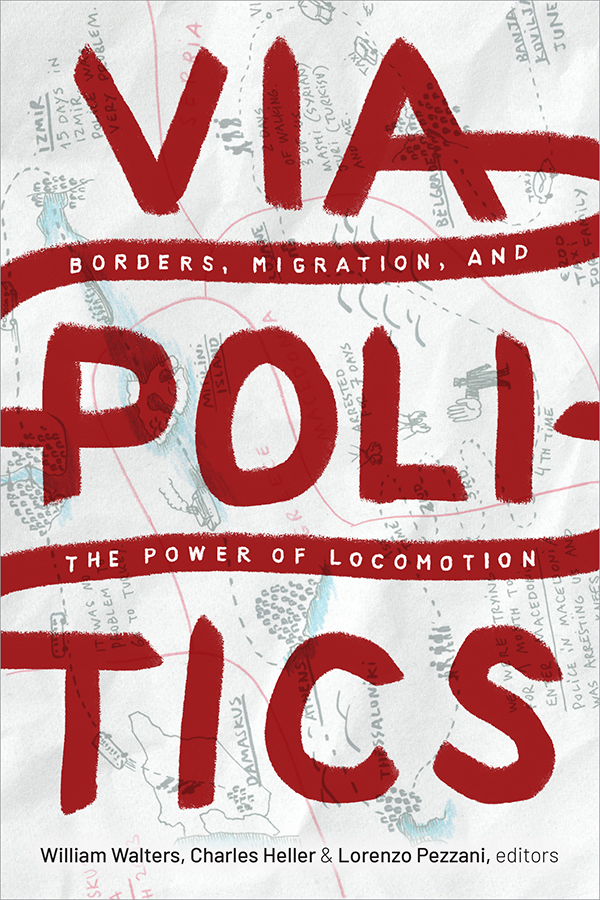Book Review: Viapolitics: Borders, Migration, and the Power of Locomotion
Posted
Time to read
Guest post by Özlem Atar. Özlem holds a PhD in Communication Sciences from Hacettepe University in Türkiye and is writing her second doctoral thesis in Cultural Studies at Queen's University, Canada. Özlem`s research at Queen's engages Trump Era narratives of irregular migration to the United States. Özlem explores the intersection of migrant justice and literature. Her Twitter handle is @OzlemAtar.
Review of Viapolitics: Borders, Migration, and the Power of Locomotion, edited by William Walters, Charles Heller, and Lorenzo Pezzani (Duke, 2022).
 Viapolitics conceptualises the vehicle, after the border and the camp, as the third component in migratory processes and successfully covers current viapolitical research in various contexts. The editors announce their purpose as “to accord the vehicle, its infrastructure, and the material geographies it navigates a central place in the study of contemporary migration and borders” (1). The book includes ten essays presented in three sections, in addition to the editors` theoretical groundwork in the “Introduction” and Renabir Samaddar`s “Afterword”, where the author sketches potential directions that research attentive to viapolitics might take.
Viapolitics conceptualises the vehicle, after the border and the camp, as the third component in migratory processes and successfully covers current viapolitical research in various contexts. The editors announce their purpose as “to accord the vehicle, its infrastructure, and the material geographies it navigates a central place in the study of contemporary migration and borders” (1). The book includes ten essays presented in three sections, in addition to the editors` theoretical groundwork in the “Introduction” and Renabir Samaddar`s “Afterword”, where the author sketches potential directions that research attentive to viapolitics might take.
Walters, Heller, and Pezzani identify three points of reference to explain the notion of viapolitics. First, “via” draws attention to vehicles of migration. The vehicle may function as a mobile location of collective experience where new bonds and identities are forged, as explored competently in Marwani`s chapter. Second, “via” indicates routes and mobility infrastructures including ports as well as administrative and logistical procedures. Lindquist, for instance, shows how airport terminals and minivans comprise nodes in a larger assemblage of mobility infrastructures aiming to control migrant mobility. The third use of “via” discovers how oceans and other geophysical environments are harnessed for bordering purposes. While the editors acknowledge its affinities with mobility studies, they insist on viapolitics` divergences from its more “liberal” counterpart (8). My understanding is that the notion of viapolitics is more attentive to “ruptures and controversies” in migration processes (9).
Part I clusters articles that primarily focus on vehicles of migration even though most chapters cut across the three meanings of viapolitics. Complementary to Across Oceans of Law, Renisa Mawani`s essay about The Komagata Maru`s 1924 journey between Hong Kong, British Columbia, and Calcutta offers a fresh perspective on how the journey engendered both solidarities and animosities, blurred the line between voluntary and forced migration, and turned the migrants into real and perceived revolutionaries against the British Empire. The chapter may be appreciated along with the documentary Continuous Journey and the book Undesirables by Ali Kazimi. Ethan Blue`s, Amaha Senu`s, and Julie Y. Chu`s chapters underline preoccupations with cost management and the control of the stranger in differing contexts. Blue analyses the deportation train as a “third branch in a racializing assemblage to control land, labor, and populations” in the US context between 1914 and World War II. For Blue, functioning as a tool of “selective spatial elimination”, train deportation comes dangerously close to, but differs from, Indian removal and slave transport. Senu takes the reader to Africa, exploring one of the relatively less explored migrant routes, by focusing on stowaways; Chu draws attention to the return of the human cargo through clandestine migration and low-budget air travel. Chu contends that the separation of nonhuman/cargo from human/passenger is realised through a focus on bodily dis/comfort.
Part II includes three chapters on trajectories, routes, and infrastructures of viapolitics. Johan Lindquist discusses the escort of temporary low-skilled migrant workers. The practice of “encapsulation” in the name of protection takes the central stage in Lindquist`s discussion of the interconnected set of translocal processes beginning in the migrants` village. Female domestic workers constitute a specific case of migrant infantilization. Lindquist successfully makes the case that framed in the paternalistic language of protection, low-skilled migrant mobility in Indonesia is rooted in colonial relations between the state and its rural populations. The chapter will be of interest to scholars working on documented migration and wish to extend their gaze into temporary worker mobility in Indonesia. Maribel Casas-Cortes and Sebastian Cobarrubias contest what they label “routes thinking” among various actors of migration governance by countering the sleek maps of migrant routes to the EU with collaboratively created “countercartograhies” accounting for migrants` embodied experiences. In their view, routes thinking “embraces mobile surveillance across extranational territories through dispersed infrastructures of contention” to disrupt migrant trajectories (154). The essay fittingly points at the link between the current border externalisation practices enabled by the i-Map project and the historical colonial and settler colonial frontier making. However, the researchers shy away from exploring this eerie resemblance thoroughly. Also, the coercion the EU deploys in its ‘cooperation’ with ‘partner’ governments in Africa could be highlighted further. Likewise, Sabine Hess and Bernd Kasparek focus on Europe-bound migration infrastructures by detailing the four phases of the Balkan Route in 2015. Hess and Kasparek`s use of “corridor” recalls the notion of encapsulation in Lindquist`s discussion. The researchers attempt to ground mobility along the Balkan Route in a deeper past, but their analysis hardly goes far into the past beyond the 1990s.
Part III is dedicated to a discussion of the geophysics of migration in three co-written chapters. Charles Heller and Lorenzo Pezzani confront the spectacularization of overcrowded migrant boats and call attention to “the other boats” implicated in inflicting “liquid violence” in the Mediterranean Sea; Glenda Garelli and Martina Tazzioli explore the fragmented and disrupted nature of migrant trajectories along the Alpine Route. Garelli and Tazzioli`s essay aligns well with Cortes and Cobarrubias`s discussion of migrant cartographies in Part II. Clara Lecadet and William Walters` article stands out from the other two in this section in several aspects. First, it introduces aerial deportation. Second, it explicitly discusses the importance of images. Lastly, the article`s collage-like presentation of several aerial removal stories enacts the bottom-up research writing methodology the editors endorse in the rest of the volume.
Viapolitics is impressive in its judicious use of visuals including maps, satellite images, migrant drawings, and archival images. The contributors stress how images are capable of arousing sympathy and may be marshalled to mobilise publics in support of funding and legislation for oppressive border and mobility controlling policies. To quote Hess and Kasparek, images that accompany words enable “a discursive push” within the concerted efforts for new migration policies. From photographs testifying to violence doled out to refugees to those precluding the presence of other vessels that watch “the left-to-die boats” in Heller and Pezzani`s essay, images are used cleverly in the book.
Another strength is the insistence on collaboration. In addition to the co-written chapters, stitching together disparate disciplinary traditions throughout the volume allows forming newer windows of engagement and research possibilities. Such collaboration also brings about methodological variety including archival research, critical ethnography, forensic architecture, and artistic narratives. Furthermore, many essays in Viapolitics move away from cold social scientific research writing by introducing the subject matter through concrete cases. This bottom-up strategy certainly works well and may attract more audiences.
I recommend Viapolitics to scholars and students of migration and border studies, migration sociology, and political science. Cultural studies scholars will also benefit if their research pertains to migrants` development of new trajectories of mobility in the face of increasingly restrictive migration and border policies. The book is appealing to me because in my major project I focus on irregular migrants including asylum seekers and refugees without paying much attention to how vehicles, routes, viapolitical infrastructures, and environments inform their trajectories. The “viapolitical gaze” of Williams and colleagues encourages a new awakening.
I acknowledge the editors` desire to ensure variety with respect to contexts in the volume. Still, Europe remains the most explored continent with occasional springs into other parts of the globe. There could be essays on intracontinental migrant mobility in Africa and South America. Lack of attention to these regions seems like a glaring void. Furthermore, I agree with Lacedet and Walters that there is a lacuna of research about migrants in return contexts. Future collaboration with scholars who turn their attention to the deportee receiving countries, such as Susan Bilber Coutin, might be one direction in viapolitical studies. In addition, Viapolitics` temporal scale might be expanded back in time. As Cortes and Cobarrubias note in an endnote, there is an urgent need for “a long history” of viapolitics.
The Deportation Machine by Adam Goodman and The Deportation Express by Ethan Blue may supplement Viapolitics regarding the long history of expulsion from the United States. For those wishing to overcome nearsightedness and Eurocentrism in mobility studies, which the editors lament, Martin Lemberg-Pedersen, Sharla M. Fett, and Lucy Mayblin`s Postcoloniality and Forced Migration is another good source. In addition, Rose Jaji`s analysis of north to south mobility in Deviant Destinations may accompany Viapolitics. Lastly, those desiring to overcome the persistent myopic presentism of migration studies may find Jan Driessen`s edited volume An Archaeology of Forced Migration helpful.
Any comments about this post? Get in touch with us! Send us an email, or post a comment here or on Facebook. You can also tweet us.
How to cite this blog post (Harvard style):
Ö. Atar. (2023) Book Review: Viapolitics: Borders, Migration, and the Power of Locomotion. Available at:https://blogs.law.ox.ac.uk/border-criminologies-blog/blog-post/2023/01/book-review-viapolitics-borders-migration-and-power. Accessed on: 19/04/2024Keywords:
Share
YOU MAY ALSO BE INTERESTED IN
With the support of













